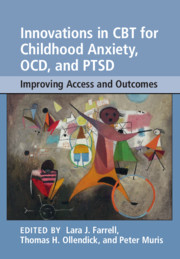Book contents
- Innovations in CBT for Childhood Anxiety, OCD, and PTSD
- Innovations in CBT for Childhood Anxiety, OCD, and PTSD
- Copyright page
- Contents
- Figures
- Tables
- Contributors
- Preface
- Acknowledgments
- Part I Anxiety Disorders
- Part II Obsessive-Compulsive Disorder
- 13 Phenomenology and Standard Care of OCD in Children and Adolescents
- 14 Evidence-Based Assessment of Child Obsessive-Compulsive Disorder (OCD)
- 15 Self-Help Treatments for Childhood Obsessive-Compulsive Disorder Including Bibliotherapy
- 16 New Technologies to Deliver CBT for Young Children with Obsessive-Compulsive Disorder
- 17 Interpretation and Attentional Bias Training
- 18 Innovations in Treating OCD
- 19 Pharmacologic-Augmented Treatments
- 20 Enhanced Family Approaches in Childhood OCD
- 21 Treatments for Obsessive-Compulsive Disorder and Comorbid Disorders
- 22 Transdiagnostic Approaches
- 23 Pediatric OCD
- 24 New Wave Therapies for Pediatric OCD
- Part III Post-Traumatic Stress Disorder
- Index
- References
13 - Phenomenology and Standard Care of OCD in Children and Adolescents
from Part II - Obsessive-Compulsive Disorder
Published online by Cambridge University Press: 12 April 2019
- Innovations in CBT for Childhood Anxiety, OCD, and PTSD
- Innovations in CBT for Childhood Anxiety, OCD, and PTSD
- Copyright page
- Contents
- Figures
- Tables
- Contributors
- Preface
- Acknowledgments
- Part I Anxiety Disorders
- Part II Obsessive-Compulsive Disorder
- 13 Phenomenology and Standard Care of OCD in Children and Adolescents
- 14 Evidence-Based Assessment of Child Obsessive-Compulsive Disorder (OCD)
- 15 Self-Help Treatments for Childhood Obsessive-Compulsive Disorder Including Bibliotherapy
- 16 New Technologies to Deliver CBT for Young Children with Obsessive-Compulsive Disorder
- 17 Interpretation and Attentional Bias Training
- 18 Innovations in Treating OCD
- 19 Pharmacologic-Augmented Treatments
- 20 Enhanced Family Approaches in Childhood OCD
- 21 Treatments for Obsessive-Compulsive Disorder and Comorbid Disorders
- 22 Transdiagnostic Approaches
- 23 Pediatric OCD
- 24 New Wave Therapies for Pediatric OCD
- Part III Post-Traumatic Stress Disorder
- Index
- References
- Type
- Chapter
- Information
- Innovations in CBT for Childhood Anxiety, OCD, and PTSDImproving Access and Outcomes, pp. 289 - 312Publisher: Cambridge University PressPrint publication year: 2019
References
- 1
- Cited by

